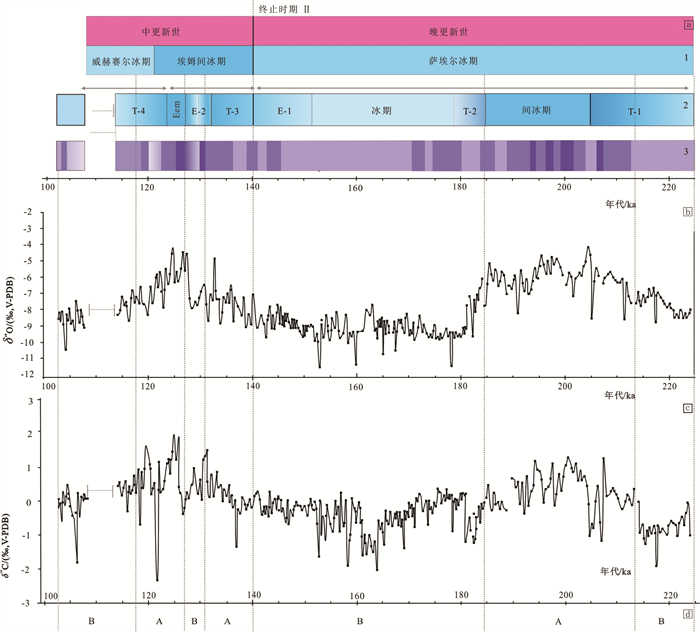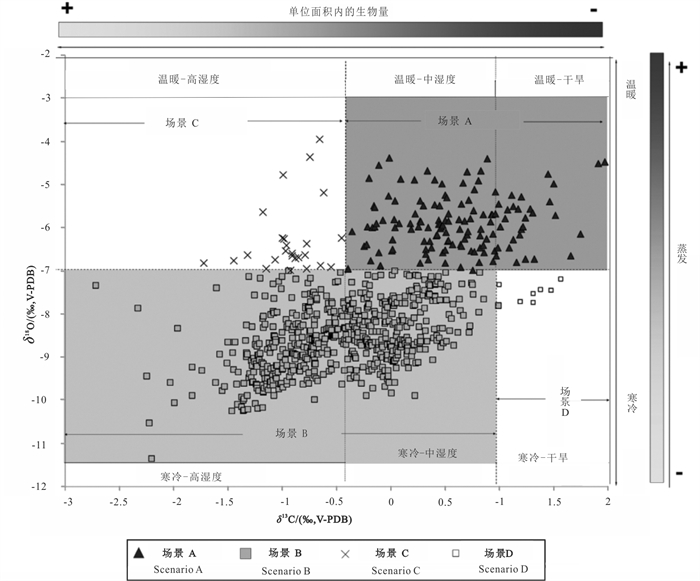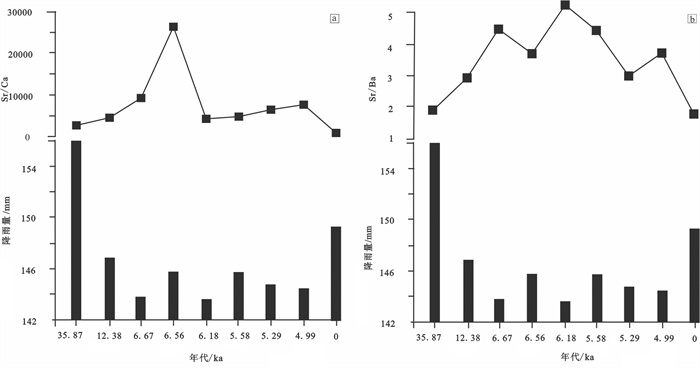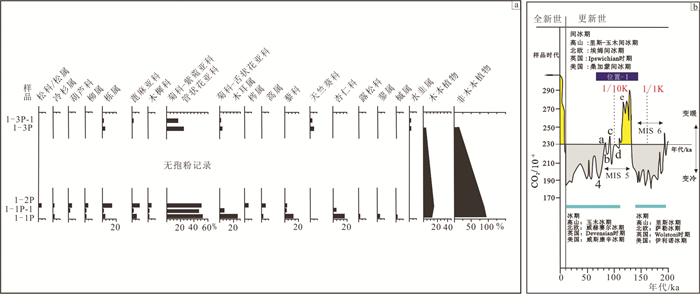Terrestrial hot-spring travertine: An important window into paleoclimate reconstruction
-
摘要:
研究目的 陆地热泉钙华作为火山、地热区常见的陆相碳酸盐岩沉积物/岩被广泛用于恢复古环境,但其中可反映古气候信息的代用指标多受复杂外界条件变化控制,因此利用热泉钙华进行古气候信息提取有待深入研究。
研究方法 本文对当前热泉钙华在重建古气候信息方面的成功案例进行了总结,并梳理了与热泉钙华沉积相关的各类气候、非气候影响因素。
研究结果 研究认为针对热泉钙华进行古气候恢复代用指标的选取,目前较为可行的有C-O同位素、主微量元素,孢粉学数据由于孢粉保存的局限性,可作为佐证信息,配合其他气候代用指标来检验古气候意义的正确与否,同时需将热泉钙华中各项气候代用指标与生物地层学、冰芯、石笋等相对成熟的古气候研究手段进行对比,使各类古气候替代指标相互验证,从而更好的解读热泉钙华中古气候信息。
结论 利用热泉钙华中的各项气候代用指标进行可靠的古气候信息提取与恢复具有可行性。
Abstract:This paper is the result of hydrogeological and environmental geological survey engineering.
Objective Terrestrial hydrothermal spring travertine, as a common terrestrial carbonate sediment/rock in volcanic and geothermal areas, is widely used to restore paleoenvironment, but the proxy indicators that can reflect paleoclimate information are mostly controlled by complex external conditions. The extraction of paleoclimate information from hot spring travertine requires further research.
Methods This paper summarizes the current successful cases of hydrothermal travertine in reconstructing paleoclimate information, and sorts out various climatic and non- climatic influencing factors related to the deposition of hydrothermal travertine.
Results The authors believe that C- O isotopes, major and trace elements are more feasible for the selection of palaeoclimate restoration proxies for hydrothermal travertine. The palynological data can be used as corroborative information due to the limitation of sporopollen preservation, and can be used in conjunction with other climate proxies. indicators to test whether the palaeoclimate significance is correct or not. At the same time, it is necessary to compare various climatic proxies in thermal spring travertine with relatively mature paleoclimate research methods such as biostratigraphy, ice cores, stalagmites, etc., so that various paleoclimate proxies can be verified with each other, so as to better obtain the information on the medieval climate of the hot spring travertine.
Conclusion It is feasible to extract and restore reliable paleoclimate information by using various climatic proxies in hot spring travertine.
-

-
图 1 土耳其西南部Denizli地区热泉钙华C和O同位素曲线(据Toker et al., 2015修改)
Figure 1.
图 2 西班牙Guadix-Baza盆地钙华上部地层δ18O与δ13C数据综合解释(据Prado-Pérez et al., 2013修改)
Figure 2.
图 3 西班牙Alicún de las Torres钙华碳氧同位素变化代表的气候场景与古气候意义(据Prado-Pérez et al., 2013修改)图中X轴和Y轴分别表示δ13C、δ18O值的古气候含义
Figure 3.
图 4 荣玛钙华Sr/Ca、Sr/Ba比值与降雨量变化趋势图(据覃建勋等,2014修改)
Figure 4.
图 5 土耳其西南部Denizli地区花粉图与晚更新世和全新世阶段同位素曲线(据Toker et al., 2015修改)
Figure 5.
表 1 常用碳酸盐岩氧同位素恢复古温度方程
Table 1. common oxygen isotopic thermometers used in carbonate systems

表 2 腾冲古钙华水温计算结果与现代热泉水温比较
Table 2. Comparison of the calculations of ancient travertine versus modern water temperatures in Tengchong
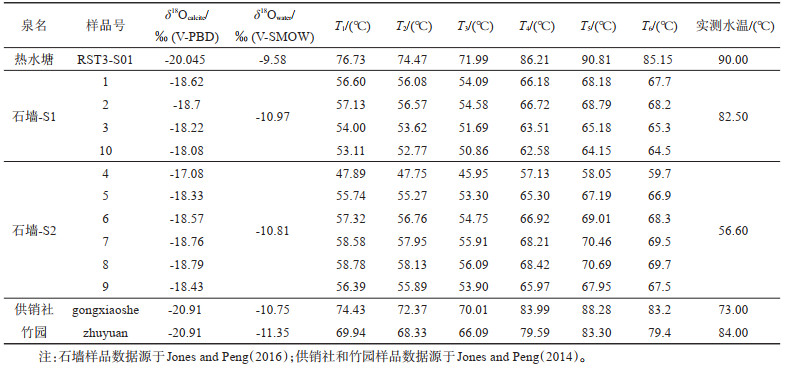
-
Affek H P, Zaarur S. 2014. Kinetic isotope effect in CO2 degassing: Insight from clumped and oxygen isotopes in laboratory precipitation experiments[J]. Geochimica et Cosmochimica Acta, 143: 319-330. doi: 10.1016/j.gca.2014.08.005
Allen J R M, Huntley B. 2009. Last Interglacial palaeovegetation, palaeoenvironments and chronology: A new record from Lago Grande di Monticchio, southern Italy[J]. Quaternary Science Reviews, 28(15/16): 1521-1538.
Andrews J E, Brasier A T. 2005. Seasonal records of climatic change in annually laminated tufas: Short review and future prospects[J]. Journal of Quaternary Science, 20(5): 411-421. doi: 10.1002/jqs.942
Andrews J E, Riding R, Dennis P F. 1993. Stable isotopic compositions of recent freshwater cyanobacterial carbonates from the British Isles: Local and regional environmental controls[J]. Sedimentology, 40(2): 303-314. doi: 10.1111/j.1365-3091.1993.tb01765.x
Andrews J E. 2006. Palaeoclimatic records from stable isotopes in riverine tufas: Synthesis and review[J]. Earth-Science Reviews, 75(1/4): 85-104.
Anzalone E, D'Argenio B, Ferreri V. 2017. Depositional trends of travertines in the type area of Tivoli (Italy)[J]. Rendiconti Lincei, 28(2): 341-361. doi: 10.1007/s12210-017-0595-1
Bertini A, Minissale A, Ricci M. 2008. Use of Quaternary travertine of central-southern Italy as archives of paleoclimate, paleohydrology and neotectonics[J]. Ital. J. Quatern. Sci., 21: 99-112.
Bertini A, Minissale A, Ricci M. 2013. Palynological approach in upper Quaternary terrestrial carbonates of central Italy: Anything but a'mission impossible'[J]. Sedimentology, 61(1): 200-220.
Birks H J B, Heiri O, H. Sepp-, Anne E B. 2010. Strengths and weaknesses of quantitative climate reconstructions based on Late-Quaternary Biological Proxies[J]. The Open Ecology Journal, 3: 68-110.
Bisse S B, Ekomane E, Eyong J T, Ollivier V, Douville E, Nganne M J, Bitom L D. 2018. Sedimentological and geochemical study of the Bongongo and Ngol travertines located at the Cameroon Volcanic Line[J]. Journal of African Earth Sciences, 143: 201-214. doi: 10.1016/j.jafrearsci.2018.03.028
Brasier A T, Andrews J E, Marca-Bell A D, Dennis P F. 2010. Depositional continuity of seasonally laminated tufas: Implications for δ18O based palaeotemperatures[J]. Global and Planetary Change, 71(3): 160-167.
Brogi A, Capezzuoli E, Buracchi E, Branca M. 2012. Tectonic control on travertine and calcareous tufa deposition in a low-temperature geothermal system (Sarteano, Central Italy)[J]. Journal of the Geological Society, 169(4): 461-476. doi: 10.1144/0016-76492011-137
Brogi A, Capezzuoli E. 2009. Travertine deposition and faulting: the fault-related travertine fissure-ridge at Terme S[J]. International Journal of Earth Sciences, 98(4): 931-947. doi: 10.1007/s00531-007-0290-z
Brogi A. 2004. Faults linkage, damage rocks and hydrothermal fluid circulation: Tectonic interpretation of the RapolanoTerme travertines (southern Tuscany, Italy) in the context of Northern Apennines Neogene-Quaternary extension[J]. Eclogae Geologicae Helvetiae, 97(3): 307-320. doi: 10.1007/s00015-004-1134-5
Campbell I D, Campbell C. 1994. Pollen preservation: Experimental wet-dry cycles in saline and desalinated sediments[J]. Palynology, 18(1): 5-10. doi: 10.1080/01916122.1994.9989434
Capezzuoli E, BrogiA, Ricci M, Bertini A. 2011. Travertines and Calcareous Tufa in Southern Tuscany (Central Italy)[M]. Field Trip Guide Book of ISTT (International school of travertine and tufa). Ed. Il Campano, Pisa, 66.
Capezzuoli E, Gandin A, Pedley M. 2014. Decoding tufa and travertine (fresh water carbonates) in the sedimentary record: The state of the art[J]. Sedimentology, 61(1): 1-21. doi: 10.1111/sed.12075
Cerling T E, Solomon D K, Quade J, Bowman J R. 1991. On the isotopic composition of carbon in soil carbon dioxide[J]. Geochimica et Cosmochimica Acta, 55(11): 3403-3405. doi: 10.1016/0016-7037(91)90498-T
Chafetz H S, Guidry S A. 2003. Deposition and diagenesis of Mammoth Hot Springs travertine, Yellowstone National Park, Wyoming, U.S.A. [J]. Canadian Journal of Earth Sciences, 40(11): 1515-1529. doi: 10.1139/e03-051
Chafetz H, Rush P F, Utech N M. 1991. Microenvironmental controls on mineralogy and habit of CaCO3 precipitates: An example from an active travertine system[J]. Sedimentology, 38(1): 107-126. doi: 10.1111/j.1365-3091.1991.tb01857.x
Chen Lei, Qin Kezhang, Li Guangming, Xiao Bo, Li Jinxiang, Jiang Huazhai, Chen Jinbiao, Zhao Junxing, Fan Xin, Han Fengjie, Huang Shufeng, Ju Yitai. 2011. Geochemical characteristics and origin of skarn rocks in the Nuri Cu-Mo-W deposit, sourthen Xizang[J]. Geology and Exploration, 47(1): 78-88 (in Chinese with English abstract).
Claes H, Degros M, Soete J, Claes S, Kele S, Mindszenty A, Török á, Desouky E H, Vanhaecke F, Swennen R. 2017. Geobody architecture, genesis and petrophysical characteristics of the Budakalász travertines, Buda Hills (Hungary)[J]. Quaternary International, 437: 107-128. doi: 10.1016/j.quaint.2016.09.007
Coplen T B. 2007. Calibration of the calcite-water oxygen-isotope geothermometer at Devils Hole, Nevada, a natural laboratory[J]. Geochimica et Cosmochimica Acta, 71(16): 3948-3957. doi: 10.1016/j.gca.2007.05.028
Craig H, Gordon L I, Horibe Y. 1963. Isotopic exchange effects in the evaporation of water: 1. Low-temperature experimental results[J]. Journal of Geophysical Research, 68(17): 5079-5087. doi: 10.1029/JZ068i017p05079
Craig H. 1965. The Measurement of Oxygen Isotope Temperatures[M]. Stable Isotopes in Oceanographic Studies and Paleotemperatures, 3: 161-182.
Cruz F W, Karmann I, Viana O, Burns S J, Ferrari J A, VuilleM, Sial A N, Moreira M Z. 2005. Stable isotope study of cave percolation waters in subtropical Brazil: Implications for paleoclimate inferences from speleothems[J]. Chemical Geology, 220(3/4): 245-262.
Curras A, Zamora L, Reed J M, García-Soto E, Ferrero S, Armengol X, Mezquita-Joanes F, Marqués M A, Riera S, Julià R. 2012. Climate change and human impact in central Spain during Roman times: High-resolution multi-proxy analysis of a tufa lake record (Somolinos, 1280 m asl)[J]. Catena. 89(1): 31-53. doi: 10.1016/j.catena.2011.09.009
Daëron M, Drysdale R N, Peral M, Huyghe D, Blamart D, Coplen T B, Lartaud F, Zanchetta G. 2019. Most Earth-surface calcites precipitate out of isotopic equilibrium[J]. Nature Communications, 10(1): 429. doi: 10.1038/s41467-019-08336-5
De Filippis L, Faccenna C, Billi A, Anzalone E, Brilli M, Ozkul M, Soligo M, Tuccimei P, Villa I M. 2012. Growth of fissure ridge travertines from geothermal springs of Denizli Basin, western Turkey[J]. Geological Society of America Bulletin, 124(9/10): 1629-1645.
De Filippis L, Faccenna C, Billi A, Anzalone E, Brilli M, Soligo M, Tuccimei P. 2013. Plateau versus fissure ridge travertines from Quaternary geothermal springs of Italy and Turkey: Interactions and feedbacks between fluid discharge, paleoclimate, and tectonics[J]. Earth-Science Reviews, 123: 35-52. doi: 10.1016/j.earscirev.2013.04.004
Demény A, Kele S, Siklósy Z. 2010. Empirical equations for the temperature dependence of calcite-water oxygen isotope fractionation from 10 to 70℃[J]. Rapid Communications in Mass Spectrometry, 24(24): 3521-3526. doi: 10.1002/rcm.4799
Dennis K J, Cochran J K, Landman N H, Schrag D P. 2013. The climate of the Late Cretaceous: New insights from the application of the carbonate clumped isotope thermometer to Western Interior Seaway macrofossil[J]. Earth and Planetary Science Letters, 362: 51-65. doi: 10.1016/j.epsl.2012.11.036
Dennis K J, Schrag D P. 2010. Clumped isotope thermometry of carbonatites as an indicator of diagenetic alteration[J]. Geochimica et Cosmochimica Acta, 74(14): 4110-4122. doi: 10.1016/j.gca.2010.04.005
Desmarchelier J M, Goede A, Ayliffe L K, Mcculloch M T, Moriarty K C. 2000. Stable isotope record and its palaeoenvironmental interpretation for a Late Middle Pleistocene speleothem from Victoria Fossil Cave, Naracoorte, South Australia[J]. Quaternary Science Reviews, 19(8): 763-774. doi: 10.1016/S0277-3791(99)00037-2
Dettman D L, Lohmann K C. 1995. Microsampling carbonates for stable isotope and minor element analysis: Physical separation of samples on a 20 micrometer scale[J]. Journal of Sedimentary Research, 65(3): 566-569.
Dietzel M, Tang J, Leis A, Köhler S J. 2009. Oxygen isotopic fractionation during inorganic calcite precipitation-Effects of temperature, precipitation rate and pH[J]. Chemical Geology, 268(1/2): 107-115.
Doran T L, Herries A I R, Hopley P J, Sombroek H, Hellstrom J, Hodge E, Kuhn B F. 2015. Assessing the paleoenvironmental potential of Pliocene to Holocene Tufa deposits along the Ghaap Plateau escarpment (South Africa) using stable isotopes[J]. Quaternary Research, 84(1): 133-143. doi: 10.1016/j.yqres.2015.04.008
Eiler J M. 2007. "Clumped-isotope"geochemistry-The study of naturally-occurring, multiply-substituted isotopologues[J]. Earth and Planetary Science Letters, 262(3-4): 309-327. doi: 10.1016/j.epsl.2007.08.020
Eiler J M. 2011. Paleoclimate reconstruction using carbonate clumped isotope thermometry[J]. Quaternary Science Reviews, 30(25/26): 3575-3588.
Faccenna C, Soligo M, Billi A, De Filippis L, Funiciello R, Rossetti C, Tuccimei P. 2008. Late Pleistocene depositional cycles of the Lapis Tiburtinus travertine (Tivoli, Central Italy): Possible influence of climate and fault activity[J]. Global and Planetary Change, 63(4): 299-308. doi: 10.1016/j.gloplacha.2008.06.006
Fairchild I J, Borsato A, Tooth A F, Frisia S, Hawkesworth C J, Huang Y, McDermott F, Spiro B. 2000. Controls on trace element (Sr-Mg) compositions of carbonate cave waters: Implications for speleothem climatic records[J]. Chemical Geology, 166(3): 255-269.
Fairchild I J, Smith C L, Baker A, Fuller L, Spotl C, Mattey D, Mcdermott F. 2006. Modification and preservation of environmental signals in speleothems[J]. Earth Science Reviews, 75(1): 105-153.
Fairchild I J, Treble P C. 2009. Trace elements in speleothems as recorders of environmental change[J]. Quaternary Science Reviews, 28(5/6): 449-468.
Falk E S, Guo W, Paukert A N, Matter J M, Kelemen P B. 2016. Controls on the stable isotope compositions of travertine from hyperalkaline springs in Oman: Insights from clumped isotope measurements[J]. Geochimica et Cosmochimica Acta, 192: 1-28. doi: 10.1016/j.gca.2016.06.026
Fan Shuxian, ZhengHongrui, Liu Pinggui, Guo Shengqiao. 2002. Late Quaternary sporopollen records and rapid climatic fluctuation events in the Yinchuan basin[J]. Geology in China, 29(4): 431-434 (in Chinese with English Abstract).
Fauvart N, Ali A A, Terral J, Roiron P, Blarquez O, Carcaillet C. 2012. Holocene upper tree-limits of Pinus section sylvestris in the Western Alps as evidenced from travertine archives[J]. Review of Palaeobotany and Palynology, 169: 96-102. doi: 10.1016/j.revpalbo.2011.10.003
Follieri M, Magri D, Sadori L. 1988. A 250000-years pollen record from Valle di Castiglione (Roma)[J]. Pollen et Spores, 30: 329-356.
Fouke B W, Farmer J D, Des Marais D J, Pratt L M, Sturchio N C, Burns P C, Discipulo M K. 2001. Depositional facies and aqueous-solid geochemistry of travertine-depositing hot springs (Angel Terrace, Mammoth Hot Springs, Yellowstone National Park, U.S.A. )[J]. Journal of Sedimentary Research, 70(3): 565-585.
Friedman I. 1970. Some investigations of the deposition of travertine from Hot Springs-I. The isotopic chemistry of a travertine-depositing spring[J]. Geochimica et CosmochimicaActa, 34(12): 1303-1315. doi: 10.1016/0016-7037(70)90043-8
Friedman I, O'Neil J R. 1977. Compilation of Stable Isotope Fractionation Factors of Geochemical Interest[M]. United States Geological Survey, 1-12.
Fu Lei, ZhangSenqi, JiaXiaofeng, LiShengtao, Yang Tao. 2019. Test of the paleoenvironment reconstruction of Bingling Hill travertine in large time scale[J]. Quaternary Sciences, 39(2): 510-517(in Chinese with English abstract).
Gao Jing. 2013. Hydrochemical Control Factors of Travetine Precipitation and the Significance of Laminated Travetine as Archives of Climate and Environment[D]. China University of Geosciences (Beijing)(in Chinese with English abstract).
Garnett E R, Andrews J E, Preece R C, Dennis P F. 2004. Climatic change recorded by stable isotopes and trace elements in a British Holocene tufa[J]. Journal of Quaternary Science, 19(3): 251-262. doi: 10.1002/jqs.842
Ghosh P, Adkins J, Affek H, Balta B, Guo W, Schauble E A, Schrag D, Eiler J M. 2006.13C-18O bonds in carbonate minerals: A new kind of paleothermometer[J]. Geochimica et Cosmochimica Acta, 70(6): 1439-1456. doi: 10.1016/j.gca.2005.11.014
Giustini F, Brilli M, Mancini M. 2018. Geochemical study of travertines along middle-lower Tiber valley (central Italy): Genesis, palaeo-environmental and tectonic implications[J]. International Journal of Earth Sciences, 107(4): 1321-1342. doi: 10.1007/s00531-017-1535-0
Gonfiantini R, Panichi C, Tongiorgi E. 1968. Isotopic disequilibrium in travertine deposition[J]. Earth and Planetary Science Letters, 5: 55-58. doi: 10.1016/S0012-821X(68)80012-3
Gray J, Boucot A J. 1975. Color changes in pollen and spores: A review[J]. Geological Society of America Bulletin, 86(7): 1019-1033. doi: 10.1130/0016-7606(1975)86<1019:CCIPAS>2.0.CO;2
Guan Xiuyu. 2010. Study on the Tufa and the Environment Information Significance from Annual Laminations in Huangguoshu, Guizhou[D]. China University of Geosciences (Beijing) (in Chinese with English abstract).
Hałas S, Wołacewicz W. 1982. The experimental study of oxygen isotope exchange reaction between dissolved bicarbonate and water[J]. The Journal of Chemical Physics, 76(11): 5470-5472. doi: 10.1063/1.442897
Harmon R S, Thompson P, Schwarcz H P, Ford D C. 1978. Late Pleistocene paleoclimates of North America as inferred from Stable isotope studies of speleothems[J]. Quaternary Research, 9(1): 54-70. doi: 10.1016/0033-5894(78)90082-0
Havinga A J. 1967. Palynology and pollen preservation[J]. Review of Palaeobotany and Palynology, 2(1): 81-98.
Hays P D, Grossman E L. 1991. Oxygen isotopes in meteoric calcite cements as indicators of continental paleoclimate[J]. Geology, 19(5): 441-444. doi: 10.1130/0091-7613(1991)019<0441:OIIMCC>2.3.CO;2
Hendy C H. 1971. The isotopic geochemistry of speleothems-I. The calculation of the effects of different modes of formation on the isotopic composition of speleothems and their applicability as palaeoclimatic indicators[J]. Geochimica et Cosmochimica Acta, 35(8): 801-824. doi: 10.1016/0016-7037(71)90127-X
Hu Anping, Li Xiuping, Jiang Yiming, Hu Yuanyaun, Zhang Jie. 2014. Development and application of microarea geochemistry analysis technology for carbonate reservoirs[J]. Natural Gas Geoscience, 25(1): 116-123 (in Chinese with English Abstract).
Hu Xinxin, Huang Chengmin. 2008. Tufa formation and its application in paleoenvironment and paleoclimate reconstruction[J]. World SCI-Teach R & D, 30(3): 331-335 (in Chinese with English abstract).
Huang Junhua, Hu Chaoyon, Zhou Qunfeng, Yang Guifang. 2002. Study on high-resolution carbon, oxygen isotope and trace element records and paleoclimate from Heshang Cave, the middle reach of the Yangtse River[J]. Acta Sedimentologica Sinic, 20(3): 442-446 (in Chinese with English abstract).
Huang Y, Fairchild I J. 2001. Partitioning of Sr2+ and Mg2+ into calcite under karst-analogue experimental conditions[J]. Geochimica et Cosmochimica Acta, 65(1): 47-62. doi: 10.1016/S0016-7037(00)00513-5
Ihlenfeld C, Norman M D, Gagan M K, Drysdale R N, Maas R, Webb J. 2003. Climatic significance of seasonal trace element and stable isotope variations in a modern freshwater tufa[J]. Geochimica et Cosmochimica Acta, 67(13): 2341-2357. doi: 10.1016/S0016-7037(02)01344-3
Jones B, Peng X. 2016. Mineralogical, crystallographic, and isotopic constraints on the precipitation of aragonite and calcite at Shigiang and other hot springs in Yunnan Province, China[J]. Sedimentary Geology, 345(nov): 103-125.
Jones B, Peng X. 2014. Signatures of biologically influenced CaCO3 and Mg-Fe silicate precipitation in hot springs: Case study from the ruidian geothermal area, western Yunnan Province, China[J]. Sedimentology, 61(1): 56-89. doi: 10.1111/sed.12043
Ji Liming. 1994. The Provincialization Position and the Paleoclimate of the Early Cretaceous Microflora in the MinheBasin, Gansu Province[J]. Acta Sedimentologica Sinica, 12(2): 133-142 (in Chinese with English abstract).
Kano A, Hagiwara R, Kawai T, Hori M, Matsuoka J. 2007. Climatic conditions and hydrological change recorded in a high-resolution stable-isotope profile of a recent laminated tufa on a Subtropical Island, southern Japan[J]. Journal of Sedimentary Research, 77(1): 59-67. doi: 10.2110/jsr.2007.006
Kano A, Matsuoka J, Kojo T, Fujii H. 2003. Origin of annual laminations in tufa deposits, southwest Japan[J]. Palaeogeography, Palaeoclimatology, Palaeoecology, 191(2): 243-262. doi: 10.1016/0031-0182(02)00717-4
Katz A. 1973. The interaction of magnesium with calcite during crystal growth at 25-90℃ and one atmosphere[J]. Geochimica et Cosmochimica Acta, 37(6): 1563-1586. doi: 10.1016/0016-7037(73)90091-4
Kele S, Breitenbach S F M, Capezzuoli E, Meckler A, Ziegler M, Millan I M, Kluge T, Deák J, Hanselmann K, John C, Yan Hao, LiuZaihua, Bernasconi S M. 2015. Temperature dependence of oxygen- and clumped isotope fractionation in carbonates: A study of travertines and tufas in the 6-95℃ temperature range[J]. Geochimica et Cosmochimica Acta, 168: 172-192. doi: 10.1016/j.gca.2015.06.032
Kele S, Demény A, Siklósy Z, Nemeth T, Toth M, Kovacs M B. 2008. Chemical and stable isotope composition of recent hot-water travertines and associated thermal waters, from Egerszalók, Hungary: Depositional facies and non-equilibrium fractionation[J]. Sedimentary Geology, 211(3/4): 53-72.
Kele S, özkul M, Fórizs I, Gokgoz A, Baykara M O, Alcicek M C, Nemeth T. 2011. Stable isotope geochemical study of Pamukkale travertines: New evidences of low-temperature non-equilibrium calcite-water fractionation[J]. Sedimentary Geology, 238(1/2): 191-212.
Kim S, O'Neil J R. 1997. Equilibrium and nonequilibrium oxygen isotope effects in synthetic carbonates[J]. Geochimica et Cosmochimica Acta, 61(16): 3461-3475. doi: 10.1016/S0016-7037(97)00169-5
Kluge T, John C M, Jourdan A, Davis S, Crawshaw J P. 2015. Laboratory calibration of the calcium carbonate clumped isotope thermometer in the 25-250℃ temperature range[J]. Geochimica et Cosmochimica Acta, 157: 213-227. doi: 10.1016/j.gca.2015.02.028
Kokh S N, Shnyukov Y F, Sokol E V, Novikova S A, Kozmenko O A, Semenova D V, Rybak E N. 2015. Heavy carbon travertine related to methane generation: A case study of the Big Tarkhan cold spring, Kerch Peninsula, Crimea[J]. Sedimentary Geology, 325: 26-40. doi: 10.1016/j.sedgeo.2015.05.005
Kong Zhaochen, Zhang Yun, Wang Li, DuanXiaohong, Li Yumei. 2018. The past, present and future of palynology in China-Concentrate on Quaternary palynology[J]. Science Bulletin, 63(2): 164-171 (in Chinese).
Lan Xianhong. 2003. Application of geochemical records in the study of quantitative restoration of paleotemperature[J]. Marine Geology Letters, 19(2): 9-13 (in Chinese).
Li Pingping, Ma Qianqian, Zou Huayao, Yu Xinya. Basic principle of clumped isotopes and geological applications[J]. Journal of Palaeogeography, 19(4): 713-728 (in Chinese with English abstract).
Li Qin. 2018. The Ancient Environment of the Mount Everest Area since the Late Miocene[D]. Chengdu University of Technology (in Chinese with English abstract).
Liang Wenjun, Xiao Chuantao, Xiao Kai, Lin Wan. 2015. The relationship of Late Jurassic paleoenvironment and paleoclimate with geochemical elements in Amdo Country of northern Xizang[J]. Geology in China, 42(4): 1079-1091 (in Chinese with English abstract).
Liu Yuhui, Nick B, Hu Chaoyong. 2012. Ultra-precise micromilling of porous stalagmite carbonate[J]. Rock and Mineral Aaalysis, 31(1): 103-112 (in Chinese with English abstract).
Liu Z, Zhang M, Li Q, You S. 2003. Hydrochemical and isotope characteristics of spring water and travertine in the Baishuitai area (SW China) and their meaning for paleoenvironmental reconstruction[J]. Environmental Geology, 44: 698-704. doi: 10.1007/s00254-003-0811-4
Liu Zaihua, Li Hongchun, You Zhenfeng, Wan Nairong, Sun Hailong, Liu Xiangling. 2006. Thickness and stable isotopic characteristics of modern seasonal climate-controlled sub-annual Travertine Laminas in a Travertine-depositing stream at Baishuitai, Southwest China: Implications for paleoclimate reconstruction[J]. Acta Geoscientica Sinica, 27(5): 479-486 (in Chinese with English abstract).
Liu Zaihua. 2014. Research progress in paleoclimatic interpretations of tufa and travertine[J]. Since Bulletin, 59(23): 2229-2239(in Chinese).
Lojen S, Trkov A, ščančar J, Vazqueznavarro J A, Cukrov N. 2009. Continuous 60-year stable isotopic and earth-alkali element records in a modern laminated tufa (Jaruga, river Krka, Croatia): Implications for climate reconstruction[J]. Chemical Geology, 258(3/4): 242-250.
Lorens R B. 1981. Sr, Cd, Mn and Co distribution coefficients in calcite as a function of calcite precipitation rate[J]. Geochimica et Cosmochimica Acta, 45(4): 553-561. doi: 10.1016/0016-7037(81)90188-5
Luo L, Wen H, Li Y, You Y, Luo X. 2019. Mineralogical, crystal morphological, and isotopic characteristics of smooth slope travertine deposits at Reshuitang, Tengchong, China[J]. Sedimentary Geology, 381: 29-45. doi: 10.1016/j.sedgeo.2018.12.008
Ma Zhibang, Xia Ming, Li Hongchun, Gu Delong, Peng Zicheng, Zhang Zhaofeng, Chen Yushu. 2002. Paleo-temperature change from 3ka in the east of Beijing area: Mg/Sr records of stalagmite[J], Science Bulletin (23): 1829-1834(in Chinese)
Makhnach N, Zernitskaja V, Kolosov I, Simakova G. 2004. Stable oxygen and carbon isotopes in Late Glacial-Holocene freshwater carbonates from Belarus and their palaeoclimatic implications[J]. Palaeogeography, Palaeoclimatology, Palaeoecology, 209(1/4): 73-101.
Matsuoka J, Kano A, Oba T, Watanabe T, SakaiS, Seto K. 2001. Seasonal variation of stable isotopic compositions recorded in a laminated tufa, SW Japan[J]. Earth and Planetary Science Letters, 192(1): 31-44. doi: 10.1016/S0012-821X(01)00435-6
Mccrea J M. 1950. On the isotopic chemistry of carbonates and a paleotemperature scale[J]. The Journal of Chemical Physics, 18(6): 849-857. doi: 10.1063/1.1747785
Mcdermott F. 2004. Palaeo-climate reconstruction from stable isotope variations in speleothems: A review[J]. Quaternary Science Reviews, 23(7/8): 901-918.
Meckler A N, Adkins J F, Eiler J M, Cobb K M. 2009. Constraints from clumped isotope analyses of a stalagmite on maximum tropical temperature change through the Late Pleistocene[J]. Geochmica et Cosmochimica Acta, 73(13): 863.
Mickler P J, Banner J L, Stern L, AsmeromY, Edwards R L, Ito E. 2004. Stable isotope variations in modern tropical speleothems: Evaluating equilibrium vs. kinetic isotope effects[J]. Geochimica et Cosmochimica Acta, 68(21): 4381-4393. doi: 10.1016/j.gca.2004.02.012
Minissale A, Kerrick D M, Magro G, Murrell M T, Paladini M, Rihs S, Sturchio N C, Tassi F, Vaselli O. 2002. Geochemistry of Quaternary travertines in the region north of Rome (Italy): Structural, hydrologic and paleoclimatic implications[J]. Earth Planet. Sci. Let., 203: 709-728. doi: 10.1016/S0012-821X(02)00875-0
Minissale A. 2004. Origin, transport and discharge of CO2 in central Italy[J]. Earth-Science Reviews, 66(1/2): 89-141.
Mohammadi Z, Claes H, Capezzuoli E, Mozafari M, Soete J, Aratman C, Swennen R. 2018. Lateral and vertical variations in sedimentology and geochemistry of sub-horizontal laminated travertines (-akmak quarry, Denizli Basin, Turkey)[J]. Quaternary International, 540: 146-168
Mucci A, Morse J W. 1990. Chemistry of low-temperature abiotic calcites: Experiment studies on coprecipitation. Stability and fractionation[J]. Rev. Aq. Sci., 3: 217-254.
Murton J B, Baker A, Bowen D Q, Caseldine C J, Coope G R, Currant A P, Evans J G, Field M H, Green C P, Hatton J, Ito M, Jones R L, Keen D H, Kerney M P, McEwan R, McGregor D F M, Parish D, Robinson J E, Schreve D C, Smart P L. 2001. A Late Middle Pleistocene temperate-periglacial-temperate sequence (Oxygen Isotope Stages 7-5e) near Marsworth, Buckinghamshire, UK[J]. Quaternary Science Reviews, 20(18): 1787-1825. doi: 10.1016/S0277-3791(01)00004-X
O'Brien G R, Kaufman D S, Sharp W D, Atudorei V, Parnell R A, Crossey L J. 2006. Oxygen isotope composition of annually banded modern and mid-Holocene travertine and evidence of paleomonsoon floods, Grand Canyon, Arizona, USA[J]. Quaternary Research, 65(3): 366-379. doi: 10.1016/j.yqres.2005.12.001
Okumura T, Takashima C, Shiraishi F, Akmaluddin, Kano A. 2012. Textural transition in an aragonite travertine formed under various flow conditions at PancuranPitu, Central Java, Indonesia[J]. Sedimentary Geology, 265: 195-209.
O'Neil J R, Clayton R N, Mayeda T K. 1969. Oxygen isotope Fractionation in Divalent Metal Carbonates[J]. The Journal of Chemical Physics, 51(12): 5547-5558. doi: 10.1063/1.1671982
Parrish J T, Hyland E G, Chan M A, Hasiotis S T. 2018. Stable and clumped isotopes in desert carbonate spring and lake deposits reveal palaeohydrology: A case study of the Lower Jurassic Navajo Sandstone, south-western USA[J]. Sedimentology, 66(1): 32-52.
Pentecost A, Viles H. 1994. A review and reassessment of travertine classification[J]. Géographie physique et Quaternaire, 48: 305-314.
Pentecost A. 2005. Travertine[M]. Springer Science & Business Media, 129-146.
Pingitore N E, Eastman M P. 1986. The coprecipitation of Sr2+ with calcite at 25℃ and 1 atm[J]. Geochimica et Cosmochimica Acta, 50(10): 2195-2203. doi: 10.1016/0016-7037(86)90074-8
Prado-Pérez A J, Huertas A D, Crespo M T, Sánchez A M, Pérez D V L. 2013. Late Pleistocene and Holocene mid-latitude palaeoclimatic and palaeoenvironmental reconstruction: An approach based on the isotopic record from a travertine formation in the Guadix-Baza basin, Spain[J]. Geological Magazine, 150(4): 602-625. doi: 10.1017/S0016756812000726
Qin Jianxun, Han Pen, Che Xiaochao, Yuan Guoli, Fang Bing, Wang Genhou. 2014. Resuming the Holocene paleoclimate using δ18O and trace elements of travertine in Rongma area, Xizang[J]. Earth Science Frontiers, 21(2): 312-322 (in Chinese with English abstract).
Ren Yaowu. 1998. The evolutionary characteristics of the rare earth element (REE) and application in the geology[J]. Henan Geology, 16(4): 64-69 (in Chinese with English abstract).
Ricci M, Bertini A, Capezzuoli E, Horvatincic N, Andrews J E, Fauquette S, Fedi M E. 2015. Palynological investigation of a Late Quaternary calcareous tufa and travertine deposit: The case study of Bagnoli in the Valdelsa Basin (Tuscany, central Italy)[J]. Review of Palaeobotany and Palynology, 218(SI): 184-197.
Roberts M S, Smart P L, Baker A. 1998. Annual trace element variations in a Holocene speleothem[J]. Earth and Planetary Science Letters, 154: 237-246. doi: 10.1016/S0012-821X(97)00116-7
Rodríguez-Berriguete á, Alonso-Zarza A M, Martín-García R, Cabrera M C. 2018. Sedimentology and geochemistry of a human-induced tufa deposit: Implications for palaeoclimatic research[J]. Sedimentology, 65(7): 2253-2277. doi: 10.1111/sed.12464
Schulte L, Julià R, Burjachs F, Hilgers A. 2008. Middle Pleistocene to Holocene geochronology of the River Aguas terrace sequence (Iberian Peninsula): Fluvial response to Mediterranean environmental change[J]. Geomorphology, 98(1/2): 13-33.
Sharp Z. 2007. Principles of Stable Isotope Geochemistry[M]. Pearson Prentice Hall, New Jersey, 334 -335.
Spötl C, Mattey D. 2006. Stable isotope microsampling of speleothems for palaeoenvironmental studies: A comparison of microdrill, micromill and laser ablation techniques[J]. Chemical Geology, 235(1/2): 48-58.
Sturchio N C, Pierce K L, Murrell M T, Sorey M L. 1994. Uranium-series ages of travertines and timing of the last glaciation in the Northern Yellowstone Area, Wyoming-Montana[J]. Quaternary Research, 41(3): 265-277. doi: 10.1006/qres.1994.1030
Sun H, Liu Z, Yan H. 2014. Oxygen isotope fractionation in travertine-depositing pools at Baishuitai, Yunnan, SW China: Effects of deposition rates[J]. Geochimica et Cosmochimica Acta, 133: 340-350. doi: 10.1016/j.gca.2014.03.006
Tchouatcha M S, Njoya A, Ganno S, Toyama R, Ngouem P A, Ngaha P R M. 2016. Origin and paleoenvironment of Pleistocene-Holocene Travertine deposit from the Mbere sedimentary sub-basin along the Central Cameroon shear zone: Insights from petrology and palynology and evidence for neotectonics[J]. Journal of African Earth Sciences, 118: 24-34. doi: 10.1016/j.jafrearsci.2016.01.031
Teboul P A, Durlet C, Gaucher E C, Virgone A, Girard J, Curie J, Camoin G. 2016. Origins of elements building travertine and tufa: New perspectives provided by isotopic and geochemical tracers[J]. Sedimentary Geology, 334: 97-114. doi: 10.1016/j.sedgeo.2016.01.004
Tesoriero A J, Pankow J F. 1996. Solid solution partitioning of Sr2+, Ba2+, and Cd2+ to calcite[J]. Geochimica et CosmochimicaActa, 60(6): 1053-1063. doi: 10.1016/0016-7037(95)00449-1
Toker E, Kayseri-özer M S, özkul M, Kele S. 2015. Depositional system and palaeoclimatic interpretations of Middle to Late Pleistocene travertines: Kocaba-, Denizli, south-west Turkey[J]. Sedimentology, 62(5): 1360-1383. doi: 10.1111/sed.12186
Traverse A. 2007. Paleopalynology[M]. 2nd edn. Netherlands: Springer, 1-772.
Tremaine D M, Froelich P N, Wang Y. 2011. Speleothem calcite farmed in situ: Modern calibration of δ18O and δ13C paleoclimate proxies in a continuously-monitored natural cave system[J]. Geochimica et Cosmochimica Acta, 75(17): 4929-4950. doi: 10.1016/j.gca.2011.06.005
Turi B. 1986. Stable isotopes geochemistry of travertines[C]//Fritz P, Fontes J C (eds. ). The Terrestrial Environment. Handbook of Environmental Isotope Geochemistry. Elsevier, Amsterdam, 207-238.
Urey H C. 1947. The thermodynamic properties of isotopic substances[J]. Journal of the Chemical Society (Resumed), 562-581. doi: 10.1039/jr9470000562
Verheyden S, Keppens E, Fairchild I J, Mcdermott F, Weis D. 2000. Mg, Sr and Sr isotope geochemistry of a Belgian Holocene speleothem: Implications for paleoclimate reconstructions[J]. Chemical Geology, 169(1): 131-144.
Vermoere M, Degryse P, Vanhecke L, Muchez P, Paulissen E, Smets E, Waelkens M. 1999. Pollen analysis of two travertine sections in Bask-y (southwestern Turkey): Implications for environmental conditions during the Early Holocene[J]. Review of Palaeobotany and Palynology, 105(1/2): 93-110.
Wang Hua, Yang Geng, Qin Jiaming, GuoJianqiang, Cao Jun. 2007. Records of paleoclimate changes based on the Dawan-Zhangjiagou travertine deposition profile in Huanglong, Sichuan[J]. Acta Geoscientica Sinica, 7(5): 469-474 (in Chinese with English abstract)
Wang Lan, Yang Lingqing, Wang Yaping, Feng Liang, Chen Xue, Chen Zansheng. 2012. Developments of laser ablation inductively coupled plasma mass spectrometry(LA-ICP-MS) in microanalysis[J]. Geological Bulletin of China, 31(4): 637-645 (in Chinese with English abstract).
Wang X, Cui L, Zhai J, Ding Z. 2016. Stable and clumped isotopes in shell carbonates of land snails Cathaica sp. and Bradybaena sp. in north China and implications for ecophysiological characteristics and paleoclimate studies[J]. Geochemistry, Geophysics, Geosystems, 17(1): 219-231. doi: 10.1002/2015GC006182
Weinstein-Evron M. 1987. Palynology of Pleistocene travertines from the Arava Valley, Israel[J]. Quaternary Research, 27(1): 82-88. doi: 10.1016/0033-5894(87)90051-2
Wen Huaguo, Luo Lianchao, Luo Xiaotong, You Yaxian, Du Lei. 2019. Advances and prospects of terrestrial thermal spring travertine research[J]. Acta Sedimentologica Sinica, 37(6): 1162-1180(in Chinese with English abstract).
Williams C A, Hills L V, Krause F F. 1996. Preserved organic matter and miospores in buried Middle Devonian (Givetian) paleosols: Indicators of weathering, oxidation and maturity[J]. Catena, 28(1/2): 1-19.
Wurster C M, Patterson W P, Cheatham M M. 1999. Advances in micromilling techniques: A new apparatus for acquiring high-resolution oxygen and carbon stable isotope values and major/minor elemental ratios from accretionary carbonate[J]. Computers and Geosciences, 25(10): 1159-1166. doi: 10.1016/S0098-3004(99)00052-7
Xu Qinghai, Li Manyue, Zhang Shengrui, Zhang Yahong, Zhang Panpan, Lu Jingyao. 2015. Modern pollen processes of China: Progress and problems[J]. Scientia Sinica Terrae, 45(11): 1661-1682 (in Chinese). doi: 10.1360/zd2015-45-11-1661
Xu Zenglian, Li Jianguo, Zhu Qiang, Li Hongliang, Zeng Hui, Wei Jialin, Zhang Bo, Cao Minqiang, Hong Bo. 2021. Early Cretaceous spore and pollen assemblage from the Yixian Formation in the Qianjiadian Depression of Kailu Basin and its paleoclimate evolution[J]. Geology in China, 48(6): 1924-1934 (in Chinese with English abstract).
Yan H, Sun H, Liu Z. 2012. Equilibrium vs. kinetic fractionation of oxygen isotopes in two low-temperature travertine-depositing systems with differing hydrodynamic conditions at Baishuitai, Yunnan, SW China[J]. Geochimica et Cosmochimica Acta, 95: 63-78. doi: 10.1016/j.gca.2012.07.024
Yan Hao, LiuZaihua. 2011. A review of palaeoclimatic implications from Laminated tufa and travertine[J]. Quaternary Science, 31(1): 88-95 (in Chinese with English abstract).
Yan Jiaxian. 2012. A Study of the Elements and Formation of the Travertine Laminas from Thermal Groundwater at the Wang 4 Well in Baodi District of Tianjin[D]. China University of Geosciences (Beijing) (in Chinese with English abstract).
Zhang Guofu, Wang Tianqiang, Zhou Linzhong. 2019. Preliminary study on the research progress of stable isotope of pollen[J]. Yunnan Chemical Technology, 46(10): 97-99 (in Chinese with English abstract).
Zhang H, Cai Y, Tan L, Qin S, An Z. 2014. Stable isotope composition alteration produced by the aragonite-to-calcite transformation in speleothems and implications for paleoclimate reconstructions[J]. Sedimentary Geology, 309: 1-14. doi: 10.1016/j.sedgeo.2014.05.007
Zhang Han, Wei Lai, Liao Xu, Wang Jiani, Shi QiuYue, Zhang Xian. 2020. In situ carbon stable isotope analysis of organic carbon by laser ablation-isotope ratio mass Spectrometry[J]. Chinese Journal of Analytical Chemistry, 48(6): 774-779 (in Chinese with English abstract). doi: 10.1016/S1872-2040(20)60028-7
Zhang Yingfang, Jiang Junwei. 2010. Paleoclimate significance of the Middle Jurassic flora in the Western Hills of Beijing[J]. Geology in China, 37(2): 515-524 (in Chinese with English abstract).
Zhao Xu, Yu Yang, Zhong Lei, Li Jijing. 2010. Application of palynological analysis in the study of quaternary environmental evolution[J]. Economic Research Guide, (4): 178-179 (in chinese)
陈雷, 秦克章, 李光明, 肖波, 李金祥, 江化寨, 陈金标, 赵俊兴, 范新, 韩逢杰, 黄树峰, 琚宜太. 2011. 西藏山南努日铜钼钨矿床矽卡岩地球化学特征及成因[J]. 地质与勘探, 47(1): 78-88. doi: 10.3969/j.issn.1001-1986.2011.01.019
范淑贤, 郑宏瑞, 刘平贵, 郭盛乔. 2002. 银川盆地晚第四纪孢粉记录的快速气候波动事件[J]. 中国地质, 29(4): 431-434. doi: 10.3969/j.issn.1000-3657.2002.04.019
付雷, 张森琦, 贾小丰, 李胜涛, 杨涛. 2019. 万年尺度下钙华的古环境重建检验——以青海冰凌山为例[J]. 第四纪研究, 39(2): 510- 517.
高竞. 2013. 地下热泉钙华沉积的水化学影响因素和热泉钙华微层的气候环境指示意义[D]. 中国地质大学(北京).
关秀宇. 2010. 贵州黄果树地区钙华及其环境意义研究[D]. 中国地质大学(北京).
胡安平, 李秀芝, 蒋义敏, 胡圆圆, 张杰. 2014. 碳酸盐岩储层微区地球化学分析技术的发展及应用[J]. 天然气地球科学, 25(1): 116-123. https://www.cnki.com.cn/Article/CJFDTOTAL-TDKX201401015.htm
胡欣欣, 黄成敏. 2008. 钙华成因及其在古环境与古气候重建中的应用[J]. 世界科技研究与发展, 30(3): 331-335. doi: 10.3969/j.issn.1006-6055.2008.03.025
黄俊华, 胡超涌, 周群峰, 杨桂芳. 2002. 长江中游和尚洞石笋的高分辨率同位素、微量元素记录及古气候研究[J]. 沉积学报, 20(3): 442-446. doi: 10.3969/j.issn.1000-0550.2002.03.013
吉利明. 1994. 甘肃民和盆地早白垩世孢粉植物群的古气候环境和地理分区位置[J]. 沉积学报, 12(2): 133-142. https://www.cnki.com.cn/Article/CJFDTOTAL-CJXB402.016.htm
孔昭宸, 张芸, 王力, 段晓红, 李玉梅. 2018. 中国孢粉学的过去、现在及未来——侧重第四纪孢粉学[J]. 科学通报, 63(2): 164-171. https://www.cnki.com.cn/Article/CJFDTOTAL-KXTB201802008.htm
蓝先洪. 2003. 地球化学记录在古温度定量恢复研究中的应用[J]. 海洋地质前沿, 19(2): 9-13. https://www.cnki.com.cn/Article/CJFDTOTAL-HYDT200302002.htm
李平平, 马倩倩, 邹华耀, 余新亚. 2017. 团簇同位素的基本原理与地质应用[J]. 古地理学报, 19(4): 713-728. https://www.cnki.com.cn/Article/CJFDTOTAL-GDLX201704013.htm
李秦. 2018. 珠峰地区晚中新世以来的古植被与古气候研究[D]. 四川: 成都理工大学.
梁文君, 肖传桃, 肖凯, 林婉. 2015. 藏北安多晚侏罗世古环境、古气候与地球化学元素关系研究[J]. 中国地质, 42(4): 1079-1091. doi: 10.3969/j.issn.1000-3657.2015.04.022 http://geochina.cgs.gov.cn/geochina/ch/reader/view_abstract.aspx?file_no=20150422&flag=1
刘浴辉, Nick B, 胡超涌. 2012. 疏松质石笋碳酸盐的精确微区取样[J]. 岩矿测试, 31(1): 103-112. doi: 10.3969/j.issn.0254-5357.2012.01.013
刘再华, 李红春, 游镇烽, 万乃容, 孙海龙, 刘香玲. 2006. 云南白水台现代内生钙华微层的特征及其古气候重建意义[J]. 地球学报, 27(5): 479-486. doi: 10.3321/j.issn:1006-3021.2006.05.010
刘再华. 2014. 表生和内生钙华的气候环境指代意义研究进展[J]. 科学通报, 59(23): 2229-2239. https://www.cnki.com.cn/Article/CJFDTOTAL-KXTB201423001.htm
马志邦, 夏明, 李红春, 顾德隆, 彭子成, 张兆峰, 陈玉舒. 2002. 距今3ka来京东地区的古温度变化: 石笋mg/sr记录[J]. 科学通报, (23): 1829-1834. doi: 10.3321/j.issn:0023-074X.2002.23.016
任耀武. 1998. 稀土元素演化特征及应用[J]. 河南地质, 16(4): 64-69. https://www.cnki.com.cn/Article/CJFDTOTAL-HNDD804.009.htm
覃建勋, 韩鹏, 车晓超, 袁国礼, 方斌, 王根厚. 2014. 利用荣玛地区温泉钙华δ18O及微量元素重建西藏全新世以来古气候[J]. 地学前缘, 21(2): 312-322. https://www.cnki.com.cn/Article/CJFDTOTAL-DXQY201402030.htm
王华, 杨更, 覃嘉铭, 郭建强, 曹俊. 2007. 四川黄龙大湾—张家沟钙华沉积剖面的古气候记录研究[J]. 地球学报, (5): 469-474. doi: 10.3321/j.issn:1006-3021.2007.05.008
王岚, 杨理勤, 王亚平, 冯亮, 陈雪, 陈占生. 2012. 激光剥蚀电感耦合等离子体质谱微区分析进展评述[J]. 地质通报, 31(4): 637-645. doi: 10.3969/j.issn.1671-2552.2012.04.020
文华国, 罗连超, 罗晓彤, 游雅贤, 杜磊. 2019. 陆地热泉钙华研究进展与展望[J]. 沉积学报, 37(06): 1162-1180. https://www.cnki.com.cn/Article/CJFDTOTAL-CJXB201906007.htm
许清海, 李曼玥, 张生瑞, 张娅红, 张攀攀, 卢静瑶. 2015. 中国第四纪花粉现代过程: 进展与问题[J]. 中国科学: 地球科学, 45(11): 1661-1682. https://www.cnki.com.cn/Article/CJFDTOTAL-JDXK201511005.htm
徐增连, 李建国, 朱强, 里宏亮, 曾辉, 魏佳林, 张博, 曹民强, 洪波. 2021. 开鲁盆地钱家店凹陷早白垩世义县组孢粉组合及其古气候演变[J]. 中国地质, 48(6): 1924-1934. http://geochina.cgs.gov.cn/geochina/ch/reader/view_abstract.aspx?file_no=20210619&flag=1
闫佳贤. 2012. 天津市宝坻区王四井地下热水钙华微层的成分及成因研究[D]. 中国地质大学(北京).
晏浩, 刘再华. 2011. 层状钙华及其地球化学指标的古气候/环境意义[J]. 第四纪研究, 31(1): 88-95. doi: 10.3969/j.issn.1001-7410.2011.01.12
张国富, 王天强, 周林宗. 2019. 孢粉稳定同位素研究进展初探[J]. 云南化工, 46(10): 97-99. https://www.cnki.com.cn/Article/CJFDTOTAL-YNHG201910039.htm
张晗, 魏来, 廖旭, 王佳妮, 史秋月, 张娴. 2020. 激光剥蚀原位有机碳稳定同位素分析方法[J]. 分析化学, 48(6): 774-779. https://www.cnki.com.cn/Article/CJFDTOTAL-FXHX202006012.htm
张英芳, 姜均伟. 2010. 北京西山中侏罗世植物群的古气候意义[J]. 中国地质, 37(2): 515-524. doi: 10.3969/j.issn.1000-3657.2010.02.026 http://geochina.cgs.gov.cn/geochina/ch/reader/view_abstract.aspx?file_no=20100226&flag=1
赵徐, 于洋, 钟雷, 李吉晶. 2010. 孢粉分析在第四纪环境演变研究中的应用[J]. 经济研究导刊, (4): 178-179. doi: 10.3969/j.issn.1673-291X.2010.04.078
朱大岗, 孟宪刚, 邵兆刚, 杨朝斌, 韩建恩, 余佳, 孟庆伟, 吕荣平. 2006. 西藏阿里札达盆地早更新世早期沉积及其古气候与古环境变化[J]. 中国地质, 33(6): 1276-1284. doi: 10.3969/j.issn.1000-3657.2006.06.010 http://geochina.cgs.gov.cn/geochina/ch/reader/view_abstract.aspx?file_no=20060610&flag=1
-



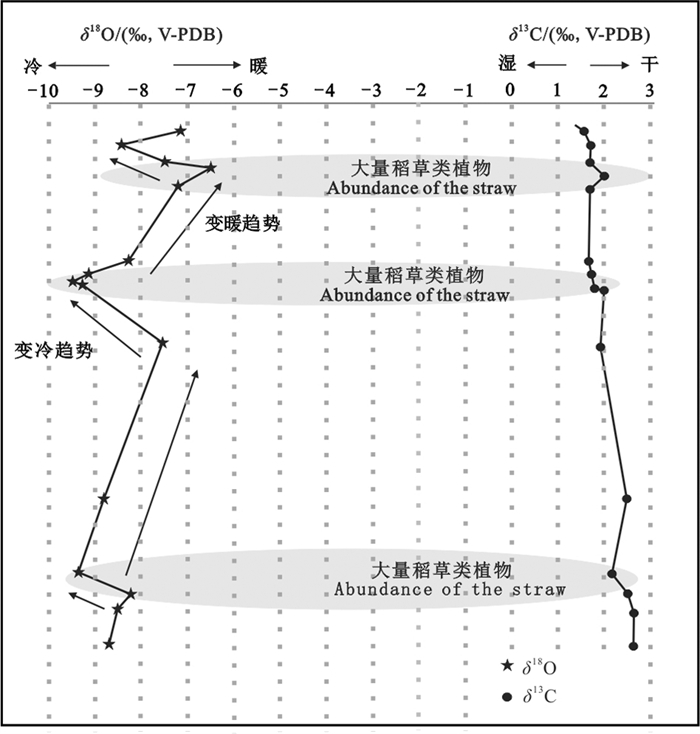
 下载:
下载:
